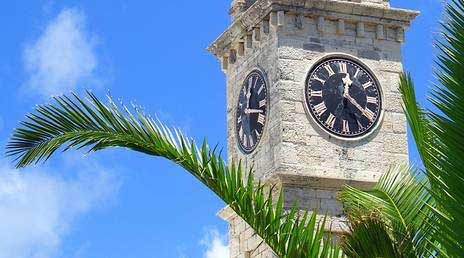USA and Canada is Divided into Multiple Time Zones
Time Zones in the USA
The United States is divided into six time zones including Alaska and Hawaii. The time zones are eastern time zone, central time zone, mountain time zone, pacific time zone, Alaska time zone and Hawaii-Aleutian time zone.
The time zones of the United States' overseas territories are Atlantic time zone that is followed in Puerto Rico and in Virgin Islands of the United States, Chamorro time zone that is observed in Guam and in Northern Mariana Islands and Samoa time zone that is applied in American Samoa.
USA Mainland and Overseas Territory Time Zone Abbreviations
The USA mainland consists of four time zones. Alaska and Hawaii have their own time zones as well as all the overseas territories. There are all together nine standard time zones in use in USA and in its overseas territories.
| Abbreviation | Time Zone Name | UTC Offset |
| SST | Samoa Standard Time | UTC-11 |
| ChST | Chamorro Standard Time | UTC-10 |
| HAST | Hawaii-Aleutian Standard Time | UTC-10 |
| HADT | Hawaii-Aleutian Daylight Time | UTC-9 |
| AKST | Alaska Standard Time | UTC-9 |
| AKDT | Alaska Daylight Time | UTC-8 |
| PST | Pacific Standard Time | UTC-8 |
| PDT | Pacific Daylight Time | UTC-7 |
| MST | Mountain Standard Time | UTC-7 |
| MDT | Mountain Daylight Time | UTC-6 |
| CST | Central Standard Time | UTC-6 |
| CDT | Central Daylight Time | UTC-5 |
| EST | Eastern Standard Time | UTC-5 |
| EDT | Eastern Daylight Time | UTC-4 |
| AST | Atlantic Standard Time | UTC-4 |
| ADT | Atlantic Daylight Time | UTC-3 |
Time Zones in Canada
Canada is divided into multiple time zones. The time zones from east to west are Newfoundland time zone, Atlantic time zone, eastern time zone, central time zone, mountain time zone and pacific time zone.
Canada's Time Zone Abbreviations
Canada follows six different standard time zones which are all part of the mainland.
| Abbreviation | Time Zone Name | UTC Offset |
| PST | Pacific Standard Time | UTC-8 |
| PDT | Pacific Daylight Time | UTC-7 |
| MST | Mountain Standard Time | UTC-7 |
| MDT | Mountain Daylight Time | UTC-6 |
| CST | Central Standard Time | UTC-6 |
| CDT | Central Daylight Time | UTC-5 |
| EST | Eastern Standard Time | UTC-5 |
| EDT | Eastern Daylight Time | UTC-4 |
| AST | Atlantic Standard Time | UTC-4 |
| ADT | Atlantic Daylight Time | UTC-3 |
| NST | Newfoundland Standard Time | UTC-3:30 |
| NDT | Newfoundland Daylight Time | UTC-2:30 |
Daylight Saving Time in USA and Canada
Daylight saving time is a practice where the clocks are set forward by an hour during the warmer part of the year. By this the sun sets an hour later in the evenings and is up an hour later in the mornings. Most areas of the USA currently observe daylight saving time during the warmer months, the exceptions are Arizona (except for the Navajo Nation, which does follow daylight saving time), Hawaii, and the overseas territories of Puerto Rico, Virgin Islands of the United States, Guam, Northern Mariana Islands, and American Samoa.
In Canada daylight saving time is followed in all provinces except in Saskatchewan. Saskatchewan is in central time zone following standard time year-round. According to geographical location, Saskatchewan is in mountain time zone. However, it is officially included in central time zone.
Effective since 2007 in the USA, daylight saving time starts on the second Sunday of March and ends on the first Sunday of November. All time changes take place at 2:00 a.m. local time. Canada follows the same daylight saving time schedule as the USA.


